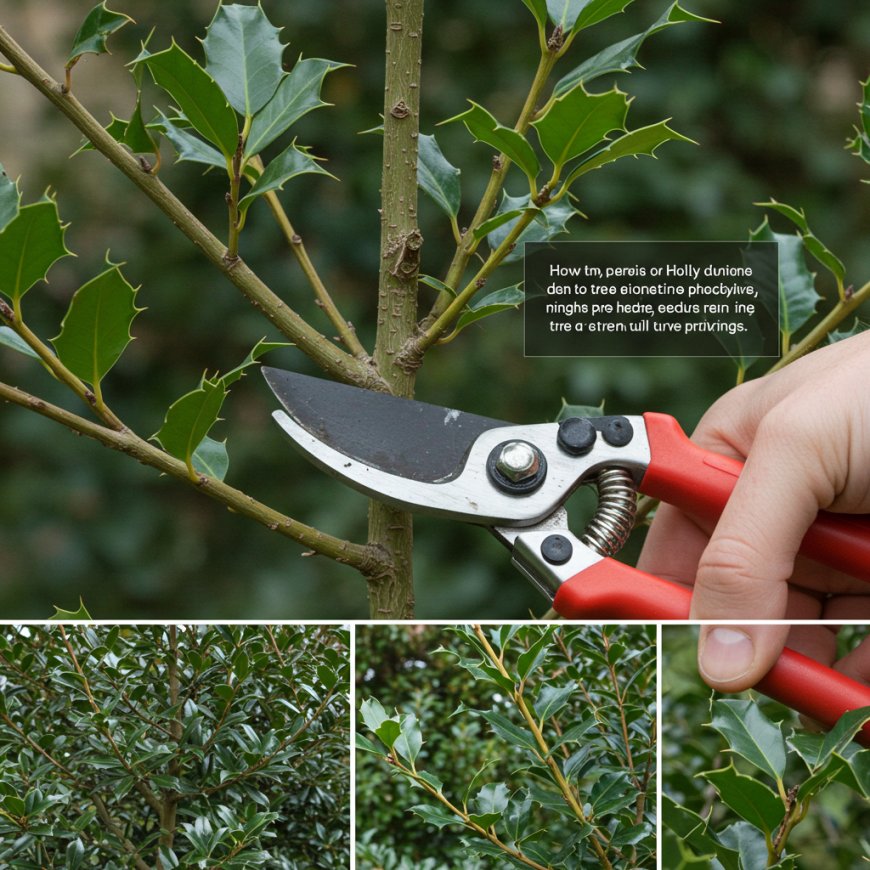How to Trim a Holly Tree: A Step-by-Step Guide for Healthy Growth and Shape
Learn how to trim a holly tree step by step for healthy growth, better shape, and vibrant berries. Discover the best time, tools, and techniques to prune your holly tree like a pro.

Holly trees are beautiful evergreens that add year-round interest to any landscape with their glossy green leaves and bright red berries. To keep your holly tree healthy, attractive, and properly shaped, its essential to know how to trim a holly tree the right way.
Pruning a holly tree not only improves its appearance but also encourages dense foliage, removes dead or diseased branches, and ensures better air circulation. Whether you have an American holly, English holly, or another variety, this guide will show you when, why, and how to trim a holly tree for the best results.
Why Trim a Holly Tree?
Understanding why trimming is important will help you approach the task with confidence. Here are the main benefits of trimming your holly tree:
-
Improves shape and size control: Pruning helps maintain a neat, compact form, especially if youre growing a holly as a hedge or topiary.
-
Removes dead, damaged, or diseased branches: This prevents the spread of disease and improves tree health.
-
Encourages new growth: Trimming stimulates healthy, dense foliage.
-
Increases light and air flow: Thinning out dense branches reduces the risk of fungal diseases.
-
Enhances berry production: Proper pruning helps maintain flower and berry production.
Best Time to Trim a Holly Tree
Timing is critical when learning how to trim a holly tree.
-
Late winter or early spring is the best time to prune most holly trees. During this period, the tree is dormant, which minimizes stress and promotes vigorous growth in spring.
-
For shaping and light maintenance, you can also prune in late summer. However, avoid heavy pruning in fall, as new growth may not harden before frost.
-
If your goal is to cut branches with berries for holiday decorations, prune selectively in late fall or early winter.
Pro tip: Avoid pruning during extremely hot or cold periods, as this can stress the tree.
Tools Youll Need to Trim a Holly Tree
Before you begin, gather the right tools for the job. Clean, sharp tools make trimming easier and reduce the risk of disease.
-
Bypass hand pruners: For small branches up to inch thick.
-
Loppers: For medium branches up to 2 inches thick.
-
Pruning saw: For larger branches over 2 inches thick.
-
Gloves: Holly leaves are sharp, so wear sturdy gardening gloves.
-
Safety goggles: Protect your eyes from falling debris.
Disinfect your tools with rubbing alcohol or a bleach solution before and after use to prevent the spread of diseases.
How to Trim a Holly Tree: Step-by-Step
Heres a simple, step-by-step guide on how to trim a holly tree effectively.
1. Assess the Tree
Step back and take a good look at your holly tree from all sides. Identify areas that are overgrown, crossing, or dead. Decide on the overall shape youd like to maintainnatural, rounded, conical, or formal hedge.
2. Remove Dead or Diseased Branches
Start by cutting away any dead, damaged, or diseased branches at the base where they meet healthy wood. This improves tree health and reduces the risk of disease spreading.
3. Thin Out Dense Areas
If the trees interior is overly dense, thin out some of the inner branches. This allows more light and air to reach the center of the tree, reducing the chances of fungal diseases and encouraging even growth.
4. Shape the Tree
Next, shape your tree by selectively trimming branches to maintain your desired form. Always cut just above a leaf node or bud facing the direction you want the new growth to go.
For a natural look, avoid cutting too much from the outer edges. Instead, prune lightly and step back often to check your progress.
5. Maintain Size
If your holly tree is getting too tall or wide, reduce its size by cutting back the longest branches to a lower lateral branch. Avoid cutting more than one-third of the trees total growth in a single year to prevent stress.
Tips for Trimming Different Types of Holly
Not all holly trees are the same, and the pruning approach can vary slightly depending on the type you have:
-
American Holly: Benefits from light annual pruning to maintain shape and remove suckers.
-
English Holly: Can be pruned more heavily to encourage dense growth and a formal shape.
-
Japanese Holly: Ideal for hedges and topiary, requiring frequent, light trimming for a neat look.
-
Yaupon Holly: Tolerates heavy pruning and can be cut back severely if needed.
Common Mistakes to Avoid
When learning how to trim a holly tree, avoid these common pitfalls:
-
Cutting too much at once: Removing more than one-third of the trees canopy can shock the plant.
-
Pruning at the wrong time: Avoid heavy pruning in fall, which can lead to winter damage.
-
Topping the tree: Never cut the top off a holly tree indiscriminately, as this can ruin its natural form.
-
Neglecting sterilization: Dirty tools can spread disease between cuts.
Caring for Your Holly Tree After Trimming
After trimming your holly tree, give it some extra care to help it recover and thrive:
-
Water deeply if the weather is dry.
-
Add a layer of mulch around the base to conserve moisture and suppress weeds, keeping it a few inches away from the trunk.
-
Fertilize in early spring if needed, using a balanced, slow-release fertilizer designed for evergreens.
Final Thoughts: Mastering How to Trim a Holly Tree
Learning how to trim a holly tree properly ensures your tree remains healthy, beautiful, and manageable for years to come. With the right tools, timing, and technique, you can maintain your hollys natural elegance while encouraging lush growth and abundant berries.
Whether youre shaping a hedge, taming an overgrown tree, or simply removing dead wood, regular pruning is one of the best things you can do for your holly trees long-term health.
Take your time, work carefully, and enjoy the process of caring for this timeless and versatile plant.




































![Play99 Login & Registration Guide for Indian Users [2025 Update]](https://www.atlantanewsplus.com/uploads/images/202507/image_140x98_6870c1df7bfcd.jpg)